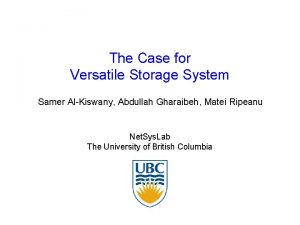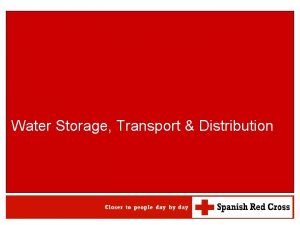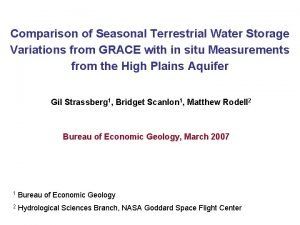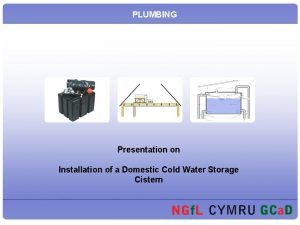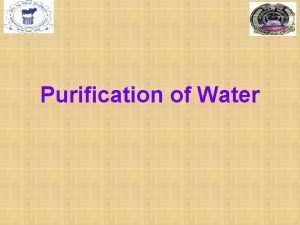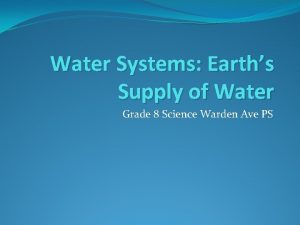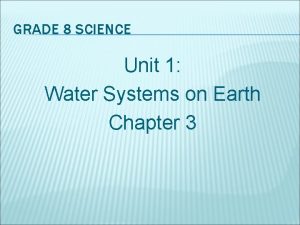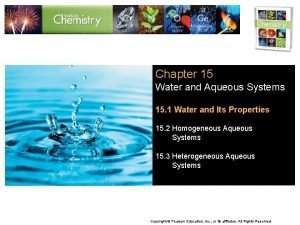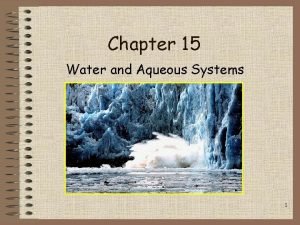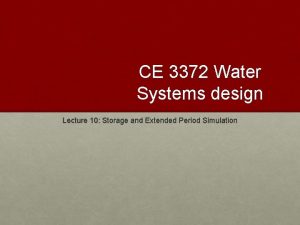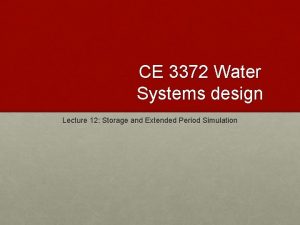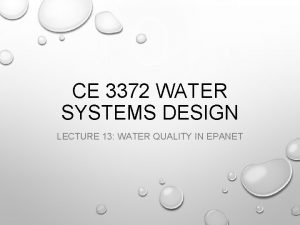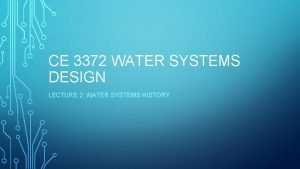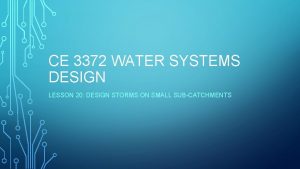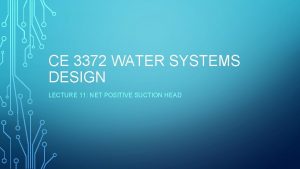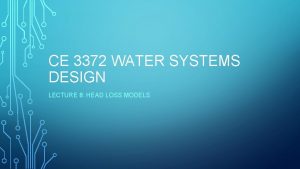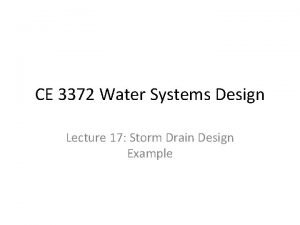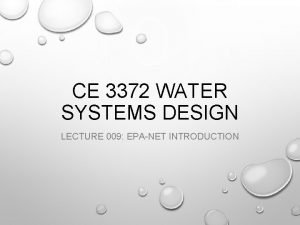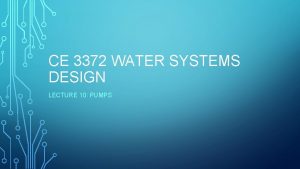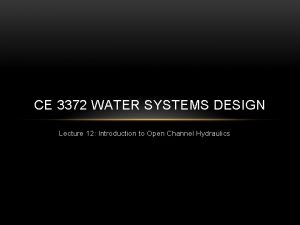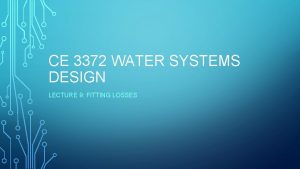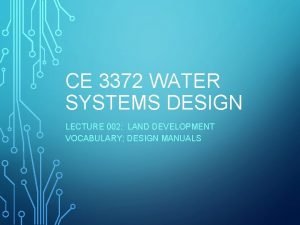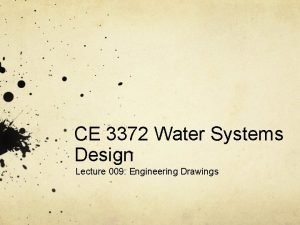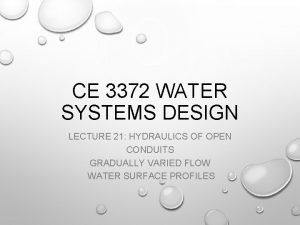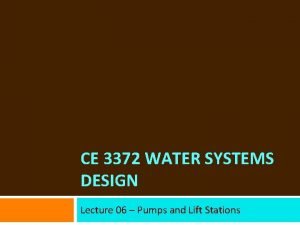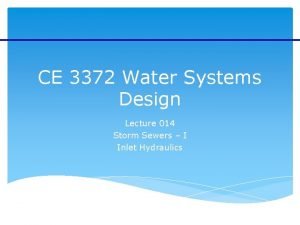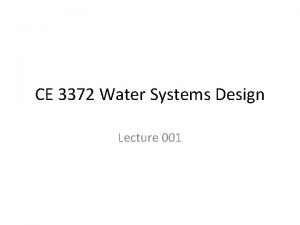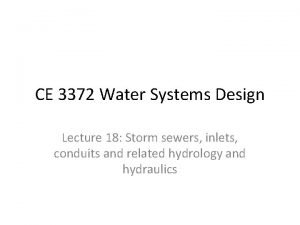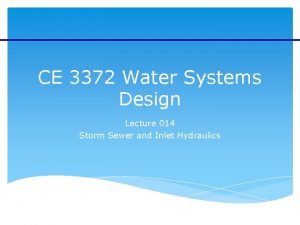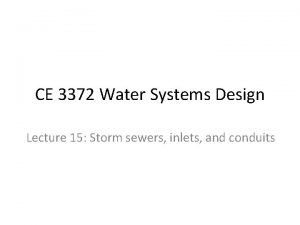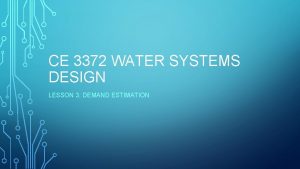CE 3372 WATER SYSTEMS DESIGN LECTURE 05 STORAGE



































- Slides: 35

CE 3372 WATER SYSTEMS DESIGN LECTURE 05: STORAGE

STORAGE • Storage is used in water supply, storm water management, and wastewater systems for a variety of reasons. • Primary reason is SERVICE STORAGE (used for flow equalization — generally things are designed for a particular steady flow rate and storage can be used to accommodate variable flow rates in a system. ) • Secondary reason is EMERGENCY STORAGE (used to provide supply during repairs and other system interrupts) Terterary reason in FIRE STORAGE (used to provide supply during fire fighting activities – could logically be considered as part of emergency) • • Storage is either elevated (above grade), at grade (reservoir, tanks, ponds, etc. ) or below grade (subsurface vaults — NOT AQUIFERS).

STORAGE COMPARTMENTS • Fire storage • Flow-equalization storage • Emergency storage Fire Flow Equalization Emergency

FIRE STORAGE • Fire storage is sufficient storage to allow the system to meet routine uses plus substantial fire flow. • The desirable volume is based on expected fire flow rates multiplied by the required fire flow duration.

FLOW-EQUALIZATION • Flow-equalization storage is sufficient storage to account for peak demands in the system without having to exceed supply capacity. • A desirable volume is 1 -2 days of average daily demand.

EMERGENCY STORAGE • Emergency storage to allow the system to operate without external supply sources for a period of time to allow for repairs or other unusual circumstances. • Without emergency storage, every upset will lead to a ”boil-water” order or substantial interruption of service — these kinds of interruptions should be rare if the system is well engineered. • A desirable volume is 1 -2 days of average daily demand.

HOW MUCH? • Engineering would tend to choose for the larger volumes • Economics will argue for the smaller volumes • The engineer will have to balance these competing choices in a design.

RESIDENCE TIME • Additionally, residence times in any storage reservoir for TREATED water should not exceed a reasonable amount disinfection residual contact time. • For chlorine/chloramine disinfection time is on the order of 6 -10 days • An hydraulic retention time of any such reservoir should be no longer than 8 days (as a reasonable rule of thumb).

HYDRAULIC RETENTION TIME • Hydraulic retention time is the ratio of storage volume to average discharge through the reservoir

SERVICE STORAGE • Purpose of storage reservoirs • Types of reservoirs • Calculating storage requirements 12/1/2020 11

STORAGE RESERVOIRS • Equalizing or Operating Storage • • Equalize pumping rate into reservoirs Provide storage for peak demand times • Fire and emergency pressures • Types • • • Surface reservoirs Standpipes Elevated tanks 12/1/2020 12

SURFACE RESERVOIRS • Where natural elevation is high enough • For inexpensive pumped storage • Covered for protection (contamination, algae growth, evaporation) • Good temperature control 12/1/2020 13

STANDPIPES • Vertical cylindrical pipe • Height > diameter • Useful storage = volume above elevation needed for minimum pressure • Low storage useful for emergencies • Steel, reinforced concrete 12/1/2020 14

ELEVATED STORAGE • Usually less $/volume of useful storage • Foundation design important • • Wind uplift Earthquake stress • General types • • Hemispherical bottom (50 -75000 gal) Double ellipsoidal (< 1. 5 MG) Radial cone bottom (up to 3 MG) Hydropillar (up to 3 MG) 12/1/2020 15

COMPOSITE ELEVATED TANKS

HYDROPILLAR™

HYDROPILLAR

WATER SPHEROIDS

STANDPIPE GROUND LEVEL

STANDPIPES AND RESERVOIRS

FRESHMIX™ STANDPIPE MIXING

COMPOSITE ELEVATED TANKS Standard CET Dimensions Capacity (in U. S. gallons) Tank Diameter (in feet) Head Range (in feet) Pedestal Diameter (in feet) 1, 000 70 40 36 1, 500, 000 87 40 48 2, 000 94 45 52 2, 500, 000 105 45 60 3, 000 118 45 64

OPERATING STORAGE • Determine hourly demand for design day • Calculate cumulative draft • Plot cumulative draft vs. time (24 hr) • Draw diagonal line representing constant pumping • Read required storage as sum of two maximum ordinates 12/1/2020 25

MASS DIAGRAM (24 -HR PUMPING) 12/1/2020 26

MASS DIAGRAM (12 -HR PUMPING) 12/1/2020 27

12/1/2020 28

12/1/2020 29

12/1/2020 30

FLOW EQUALIZATION • The engineer needs to decide which demand to use: • • Daily Peak • These volumes are added to that needed for emergency and fire flow. • Determines the tank volume required • Tank type (elevated, at-grade, buried) determines shape – elevation, diameter, min-level, max-level. • Elevated tanks have substantial structural considerations

TYPICAL INSTALLATION

STORM WATER STORAGE • Used to mitigate peak flows from development. • Provide water quality benefit. • Develop a water resource (rainwater harvesting)

UNDERGROUND “TANK” • More than a hole in the ground • • Needs structure to support surface loads Needs a way to drain completely (usually a pump)

STORAGE IN COMPUTER MODELS • Storage elements in compurer models are tanks or reservoirs (EPANET), or storage junctions (SWMM) • Have similar minimal data requirements that include: • • • Invert (bottom) elevation Min Pool elevation (above the invert) Begin Pool elevation (above the invert) Max Pool elevation (above the invert) Tank dimensions (or depth-storage curve)

TANK DESCRIPTIONS • Supply reservoir (or tank); identify reservoir pool elevation • • • Diameter May need assumptions Max Level Tank dimensions should be sensible Pipe length is given Min Level Z=315 ft Z=300 ft L 2=120 ft Node 2 Pipe 8: L 1 + L 2 = 300 ft L 1=180 ft Elevation Z=180 ft

TANK DESCRIPTIONS • Supply reservoir (or tank); identify reservoir pool elevation • Can also use a volume vs. depth table to convey tank storage capabilities -- quite similar to reservoir routing in hydrology Diameter Max Level Min Level Z=315 ft Z=300 ft L 2=120 ft Node 2 Pipe 8: L 1 + L 2 = 300 ft L 1=180 ft Elevation Z=180 ft
 Rfc 3372
Rfc 3372 Water and water and water water
Water and water and water water 01:640:244 lecture notes - lecture 15: plat, idah, farad
01:640:244 lecture notes - lecture 15: plat, idah, farad Transferring of data from auxiliary storage to main storage
Transferring of data from auxiliary storage to main storage Secondary storage vs primary storage
Secondary storage vs primary storage Uses rigid metallic platters
Uses rigid metallic platters Unified storage vs traditional storage
Unified storage vs traditional storage Operating system lecture notes
Operating system lecture notes Articulators
Articulators Lecture sound systems
Lecture sound systems Samer al-kiswany
Samer al-kiswany Storage for ibm power systems
Storage for ibm power systems Tactical storage systems
Tactical storage systems Tactical storage systems
Tactical storage systems Availability in globally distributed storage systems
Availability in globally distributed storage systems Water storage on earth
Water storage on earth Water storage
Water storage Cold water storage cistern diagram
Cold water storage cistern diagram Double pot method of disinfection of well water
Double pot method of disinfection of well water Eurocode lap lengths
Eurocode lap lengths Elemen urban design
Elemen urban design Elements of design in interior design ppt
Elements of design in interior design ppt Lecture hall acoustics
Lecture hall acoustics Game design lecture
Game design lecture Computer-aided drug design lecture notes
Computer-aided drug design lecture notes Cmos vlsi design lecture notes
Cmos vlsi design lecture notes Runtime environment in compiler design
Runtime environment in compiler design Decision support systems and intelligent systems
Decision support systems and intelligent systems Engineering elegant systems: theory of systems engineering
Engineering elegant systems: theory of systems engineering Embedded systems vs cyber physical systems
Embedded systems vs cyber physical systems Engineering elegant systems: theory of systems engineering
Engineering elegant systems: theory of systems engineering Water systems grade 8
Water systems grade 8 Bartling energy systems recently reported
Bartling energy systems recently reported Mrs bader grade 8 science
Mrs bader grade 8 science Chapter 15 water and aqueous systems answer key
Chapter 15 water and aqueous systems answer key Chapter 15 water and aqueous systems
Chapter 15 water and aqueous systems










